News
The saviour of Padaviya’s CKDu patients
Padaviya – From the comparative comfort of the Sri Jayewardenepura Hospital in Colombo, it was to the Base Hospital in this anguish-ridden area that Dr. Shamitha Dassanayake was posted as Acting Physician two years ago.
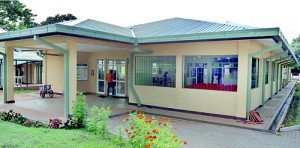
The new unit at the Padaviya Hospital. Pix by M.A. Pushpa Kumara
With patients — caught in the vice-like grip of the mysterious kidney disease — and their relatives falling at his feet and weeping, his life changed forever.
Unlike many other arm-chair experts and researchers who haggle over this or that finding with regard to the cause of Chronic Kidney Disease of Unknown Aetiology (CKDu), this doctor, almost single-handedly has done his mite to ease the suffering of those who are face-to-face with death.
These men and women whose very survival depends on dialysis, Dr. Dassanayake had found during his early days at Padaviya, when told to go to Anuradhapura Hospital, would just go home to die.
For, Anuradhapura was about 100 km away and with mostly “rice-winners” being struck down by CKDu, these families did not have the wherewithal to meet transport and accommodation costs so far away. A trip by a three-wheeler would cost Rs. 3,000 and by van Rs. 5,000.
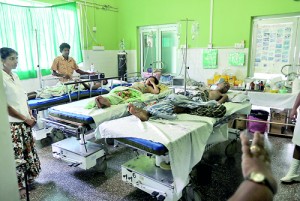 It was after seeing their plight that Dr. Dassanayake decided to tip the scales in favour of his seriously-ill patients. The need of the hour was a Dialysis Unit at Padaviya Hospital itself.
It was after seeing their plight that Dr. Dassanayake decided to tip the scales in favour of his seriously-ill patients. The need of the hour was a Dialysis Unit at Padaviya Hospital itself.
It is on a CKDu clinic day that the Sunday Times visits Padaviya, to find that Dr. Dassanayake has stepped out of the hospital for lunch. It is 4 in the evening and his lunch is a hurriedly eaten meal.
The patients’ stories are startlingly similar but at the same time heart-rending. K.W. Sunil Weera from Weli Oya is 45 and a father of three. A paddy-farmer, he realised he was ill eight years ago when he could not eat, was prone to severe headaches and dizziness. When he heard the diagnosis of “wakugadu amaruwa” he was in despair. 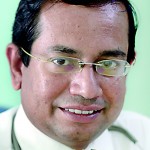 Sunil’s condition has worsened in the last two years, with severe pain in the chest, and he was being dialysed the day we visited Padaviya.
Sunil’s condition has worsened in the last two years, with severe pain in the chest, and he was being dialysed the day we visited Padaviya.
With two children, 42-year-old K.D. Priyantha Kumara who is from Padavi Sripura, also engages in paddy-farming. Struck down by the mysterious kidney disease, he drank “anam manang” (this and that) until he was compelled to go to the Anuradhapura Hospital as his condition deteriorated.
Ninety-five percent of his kidneys are “diya wela” (dissolved), he tells us sadly, with stoic resignation, as he undergoes dialysis. His neighbour on the other bed – father of four, H.P. Yasapala also from Padavi Sripura, faces the same plight.

H.P. Yasapala
Working as Acting Consultant Physician in charge of the Medical Ward and the Emergency Treatment Unit (ETU), Dr. Dassanayake was confronted with many a patient like them suffering from CKDu.
When they begin to sink, during the end-stage of the disease, and their lungs fill up with water (pulmonary oedema), Dr. Dassanayake just could not watch them die. The only option was to transfer them to the Anuradhapura Hospital, but that hospital too was bearing a heavy burden.
The patients were also reluctant to go so far preferring to quietly head back to their homes to die, he says, creating images of the Grim Reaper waiting to strike them down.
Padaviya bears double the burden of Medawachchiya, says Dr. Dassanayake, explaining that while in Medawachchiya with a population of 56,000 there are 3,125 CKDu patients, Padaviya with a population of 31,000 has 2,695.
“There is a chance of every family having at least one victim and there seems to be a funeral in some village home every day due to
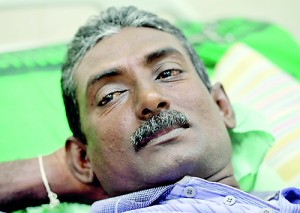
K.D. Priyantha Kumara
CKDu,” he says.
Underscoring the importance of the Padaviya Hospital, he is quick to point out that it also caters to people from parts of three provinces — Kebitigollewa and Wahalkada in the North Central Province; the new settlements of Sampath Nuwera and Weli Oya in the Northern Province and Sripura and Pulmoddai in the Eastern Province.
Discovering that the hospital’s “draining area is very high”, he was determined to develop a Dialysis Unit, while also opening up a file for each patient which included basic tests and scan reports.
When studying the early and solid work done by Dr. Tilak Abeyesekera and Dr. A.M.L. Beligaswatte who had come to the area as far back as 2003 from Kandy to hold renal clinics where 1,600 patients had been registered, he had come across a file about a donation.
Resurrecting that file, Dr. Dassanayake had started his arduous task of establishing a Dialysis Unit and water treatment plant with a reverse osmosis (RO) plant, while also improving the operating theatre and the ETU.
By April 2012, just a few months after he took up his appointment at Padaviya, he had urged the Rotarians to visit the area.
The efforts of Dr. Dassanayake — who has put his foreign post-graduate training on hold to help the beleaguered people of Padaviya — paid off when in January 2013 (last year), the Rotarians donated five sophisticated dialysis machines.
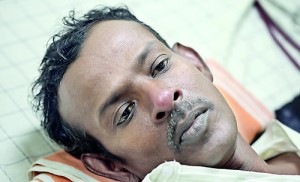
K.W. Sunil Weera
There was unstinting support from the then Regional Director of Health Services, Dr. Palitha Bandara, who is now Provincial Director, says Dr. Dassanayake.
The next issue was how to secure the consumables which cost Rs. 4,950 per dialysis session, which too he worked out with the Medical Supplies Division after several visits to the Health Ministry.
From June 2013 the machines are operational and 16 patients undergo dialysis six days per week, while there is also provision to fix five more machines, the Sunday Times learns.
The hospital with the round-the-clock ETU, however, is functioning with limited human resources — only seven Medical Officers and 35 nurses, it is understood.
Not content with only improving the hospital, meanwhile, Dr. Dassanayake has picked teachers as a target group to promote the prevention of non-communicable diseases in the area.
Padaviya being the first under the provincial health system to launch a proper Dialysis Unit, it was in recognition of “pioneering work in the care of CKDu patients” that Dr. Dassanyake was selected as the ‘Most Innovative Outstation Physician for 2013’ by the Ceylon College of Physicians.
The tribute that the thankful people of Padaviya pay Dr. Dassanayake comes in the form of blessings they shower on him every day at the tiny shrines in their humble homes.
| No countrywide register on CKDu
Having treated CKDu patients in the past two years, Dr. Shamitha Dassanayake laments the fact that so far the country has no National CKDu Patient Registry, no National CKDu Death Registry and no kidney transplant programme for CKDu victims. The Health Ministry is taking steps to overcome this, he says confidently. Delving into the lifestyle of those affected by CKDu, he says that 95% are agricultural workers. With backbreaking work, most swallow non-steroidal anti-inflammatory drugs (NSAIDs) to keep at bay back, knee and other joint pain and premature osteoarthritis. They also engage in betel-chewing and with this causing damage to their taste buds they take increased amounts of salt in their food. With salt also having a certain amount of fluoride and fluoride being present in the water that they drink, it seems to be a vicious circle, according to him. This is why it is very important to conduct a preliminary survey on what they eat and how they take their water, is his view. While working in the field, they also don’t drink enough water, he points out, referring to some studies abroad which had found that farmers temporarily get dehydrated daily, due to this, which over time leads to acute kidney injury. The heat is immense in Padaviya, says Dr. Dassanayake, adding that since February 2013 up to now there has been no rain. Conceding that the main problem of this mysterious disease is the aetiology, he details a “hard fact” which is the biopsy findings that there is chronic tubular-interstitial nephritis. The causes can be many and with the search for the aetiology never ending, he argues that at least one factor should be taken away. “If the CKDu victims fall within the triangle formed by Factor 1, Factor 2 and Factor 3, we should at least try to remove one factor. Water may be the best bet. From there, we can work to find the other factors,” he says, requesting that safe drinking water should be provided to farmers. -Depression suffered by 95% of CKDu patients who are unable to accept their condition and the fact that they would need dialysis until their death. - A serious social issue is that when the family’s breadwinner is affected, children go in search of jobs, their education gets disrupted and when the parents die the children face severe consequences. - Social stigma when finding marriage partners, while public servants are reluctant to serve in these areas. - As the farmers cannot stock up rice to feed their families till the next season because they have to sell whatever they have to meet medical bills, there is a pathetic situation in their homes. - Most people are abandoning their villages, with only a minority left behind. What did not happen during the war even in the threatened villages is happening due to CKDu — the village structure is collapsing. “In another 10 years, no people will be left in CKDu-affected villages,” is the gloomy prediction of Dr. Dassanayake. From the point of view of the health sector, he says that a preventive strategy is vital as time is running out and the country cannot await the uncovering of the aetiology. We do screening with urine dipsticks but these are not sensitive as for CKDu one needs to do both the dipstick and serum creatinine tests, he adds, urging continuous surveillance as the epidemiology seems to be changing. |


